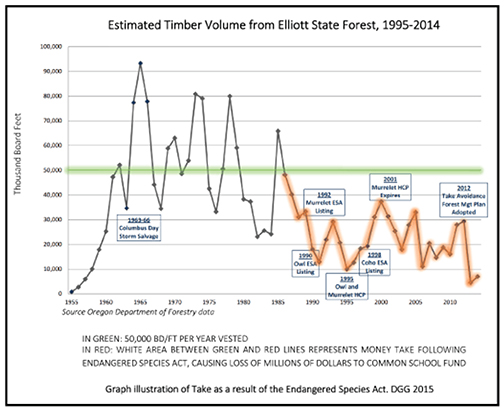
2018 SWOCC Elliott State Forest Draft Recreation Plan
Chapter 12. Forest Recreation Economics
Fig. 12.1. Elliott Timber Volumes and Endangered Species Act, 1955-2014 (Bird 2016: 3).
Forest Recreation Economics
By Scott Guthrie, Amy Kronsberg, and Maggie Boone
With the opportunity for recreation, there is an opportunity for the Elliott to grow economically, through camping, hunting, fishing and timber sales. The economic growth will help the Elliott sustain the natural resources it currently has and brings the possibility for more. When the Elliott grows in this way it will help the School Trust for future generations with revenue generated within.
Current use on Elliott
There has been a significant decline in timber revenue on the Elliott for the Common School Fund due to the threatened species that live in the forest.
According to Margaret Bird (2016: 3):
“Three threatened species live in the Elliott Forest. In 1990, the spotted owl was declared a threatened species by the U. S. Fish and Wildlife Service. In 1992, the marbled murrelet was declared a threatened species. In 1997, the Northern California Coho salmon was declared a threatened species in California but not in Oregon due to an Oregon Recovery Plan and better stream quality in Oregon.”
Due to this there has been a lot of litigation in the preceding years that has caused the Elliott to lose revenue:
“In FY 2013, the Department of State Lands lost $3 million for schools, as their expenditures to the Department of Forestry and their litigation costs exceeded their revenue by $3 million. This is the first time in 227 years of school trust history that a state has spent more than they have made from the school lands. This resulted in taking $3 million from the Oregon Common School Fund.” (Bird 2016: 2-3)
Potential for School Trust Advantage
If the existing management plan remained in place, the Elliot could sustain a harvest of about 48 to 50 million board feet (mmbf) per year. The biological potential for the Elliott could be as high as 70 mmbf per year. The 70 mmbf should be a benchmark form which to measure economic impacts as well as potential revenue generated for the Common School Fund. There is a great potential for economics on the Elliott in the future, with recreation and other opportunities. (Zybach 1994: 5)
Table 12.1. Current and Potential Elliott Recreational Income.
Type |
2017 Income |
Potential income |
Education |
Birding |
$0 |
$750 from grants; $3 per map; |
4 |
Camping |
$0 |
$3,300 per day (during season) |
2 |
Elliott History |
$0 |
$9,113 |
3 |
Roads & trails |
$0 |
$0 |
2 |
Cultural resources |
3 |
||
Ethnobotany |
$0 |
$10 per person (tags and licenses) |
3 |
Fish & habitat |
|||
Hatcheries & fisheries |
$28.50 per person |
$150 per person |
4 |
Hunting & trapping |
$0 |
Access permits $225,000; Guided hunts $18,000 (Annually) |
4 |
Local recreation |
$0 |
3 |
|
Sightseeing & photography |
$0 |
$120,000 timber clearing for viewing |
2 |
Table 12.1 is based on numbers developed for this draft plan. They demonstrate that there is currently no recreation-based income being generated in the Elliott for the Common School Fund. However, potential uses for educational value are very high. Educational potential is done with a rating of 0 through 4, with 0 being “none” and 4 being “excellent,” where there is non-monetary value in these areas.) Consensus is that investments in improving the Elliott’s signage, roads, and maps and by installing commercial campgrounds could be derived from fees, grants, donations, and selective logging sales. These improvements would also create enhanced educational opportunities for Oregon students and residents.
The most recent economic analysis of recreational income potential for the Elliott concluded: “Recreation opportunities in the [Elliott State Forest] will not significantly provide more revenue than the status quo of limited logging” (Sim et al. 2014: 30).
Potential income Barriers to Development
With little recreation currently on the Elliott, one of the barriers would consist of applying recreational resources to the Elliott to start up the economy of the recreational area. Startup costs for certain venues would consist of: making areas for sightseeing, more areas for campgrounds, putting up signs for visitors, and making access with roads and trails to these sites.
Recommendations
I would recommend leasing out or selling a small area to a cellular tower to a company and/or re-trans, high up in the Elliott, like Tenmile Butte or Cougar Pass. This would bring in some income for the trust lands and improve communication in the area for future recreation and safety inside the Elliott.
I would also recommend setting up an area near camping, fishing and other recreational areas for fees and a sign that explains that it’s for funding the Elliott and some information of how it helps their experiences.
If we put up signs to some of the entrances of the Elliott stating “Welcome to the Elliott” with some information about it, so people know when they’ve entered the area.
© 2017, 2018 Oregon Websites & Watersheds Project, Inc. & NW Maps Co.